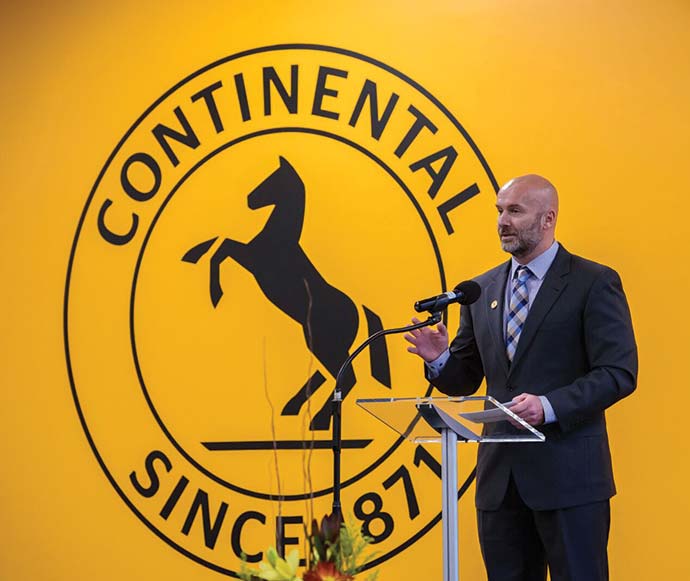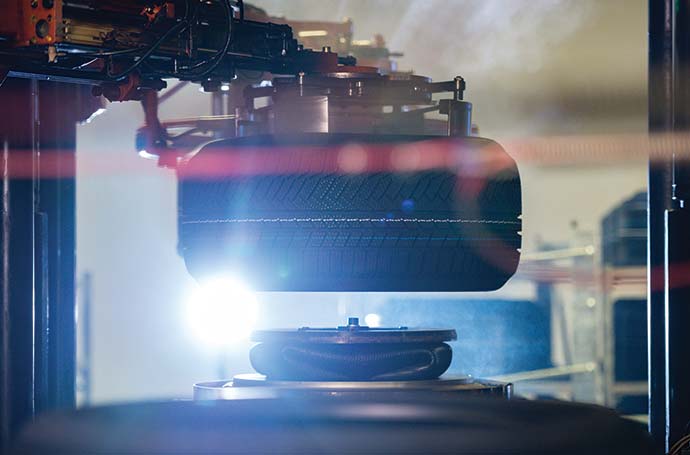More than a quarter of approximately 340 facility investment projects tracked by Site Selection and Conway analytics in the plastics sector since January 2017 are in the tire business.
That’s a whole lot of rubber hitting the road. And there’s more rolling around the bend.
A September 2018 report from Zion Market Research reported that the global tire market, valued at US$73.9 billion in 2017, is expected to generate revenue of around $98.5 billion by the end of 2024, growing at a CAGR of around 4.2% between 2018 and 2024. In addition to being driven by an increase in vehicle production, “advanced technologies such as eco tires, flat-run tires, nitrogen-using tires and others are further boosting the market growth due to the rising demand for the specialized materials which strengthens the tire and sidewalls,” said the report, noting increases in materials in such categories as elastomers, chemicals, reinforcing fillers and plasticizers, among others.

North American vehicle production is driving the tire market to new heights, with the U.S. alone producing around 12 million passenger and commercial vehicles annually. The U.S. Tire Manufacturers Association (USTMA) projects 2019 U.S. tire shipments will increase to 332.9 million units compared to 330.4 million units in 2018.
But the real growth is in Asia, says Zion, thanks to easy availability of raw material, with India and China contributing the most to the growing tire material market. “Infrastructural facilities and skilled and cheap labor force are the aspects attracting most of the international automotive manufacturers to invest in the Asia Pacific,” said the report.
Site Selection’s numbers since January 2017 substantiate Zion’s findings, tallying 15 tire manufacturing projects in China (led by Guangxi and Zhejiang), and 11 in India (led by Gujarat and Tamil Nadu). The Society of Indian Automobile Manufacturers reports that the sector produced nearly 31 million two-, three- and four-wheeled vehicles for the year ending in March 2019.
Many of those Asian plants surpass North America in terms of employees, but a U.S. project tops our list in terms of overall planned investment: Continental is investing $1.45 billion in its new truck tire plant in Clinton, Mississippi, where the company last November opened its new employee training center. In addition to supporting recruitment and retention for the tire plant, the center will be used for the company’s sales team as well as for special events for customers. Continental’s partnership with Hinds Community College also will drive employment and professional development at the facility.
“Hinds Community College is excited to serve as Continental’s training partner, not only ensuring that we support them in developing a highly skilled workforce, but also to provide ongoing training for professional growth and development of their workforce as the plant expands,” said Dr. Clyde Muse, president of the college since 1978. “Every job offered at Continental Tire creates an opportunity for someone to improve their quality of life. We will remain committed to supporting their educational and training endeavors for many years to come.”
Notably, the ribbon at the opening ceremony was not cut by company executives, but by a group of young trainees. By the time the tire plant officially starts production in 2020, around 400 employees will be hired. Approximately 2,500 jobs will be created by 2028.
The Right Chemistry
About three hours’ drive south of that tire plant, a chemical company is investing nearly the same amount of money in Geismar, Louisiana.
Methanex in July announced it would invest between $1.3 billion and $1.4 billion in its third methanol plant in Geismar, creating 62 new jobs with average annual salary of $80,000, plus benefits. The company’s cumulative investment at the site in Ascension Parish now will total more than $2.5 billion.
The three Methanex plants in Geismar will represent one of the largest methanol complexes in the world. The Geismar complex will grow to 230 total direct jobs, with the facilities supporting another 1,500 indirect jobs in the Capital Region. During the building phase on the 152-acre Waterloo LED-certified site, the new methanol project will generate more than 1,000 construction jobs. Earlier this decade, Methanex reassembled two methanol plants in Geismar with components from methanol units that were decommissioned in Chile.Methanol production began in Geismar in 2015.
“As the global leader in the methanol industry, we evaluate growth opportunities around the world,” said Mark Allard, Methanex vice president for North America, “and we are pleased that Ascension Parish will become home to our largest production site globally, with production capability of approximately 4 million metric tons per year.”
To secure the project, the State of Louisiana offered Methanex a $3 million performance-based grant to offset infrastructure costs of the project. In addition to support from Ascension Economic Development Corp. (AEDC) and the Baton Rouge Area Chamber (VRAC), Methanex is expected to utilize Louisiana’s Industrial Tax Exemption and Quality Jobs programs. “Louisiana is a very attractive location for methanol production, and the state’s investment attraction programs provide an excellent backdrop for this additional investment,” Allard said.
“The Baton Rouge area continues to be an economic engine for the state, driven in large part by this new wave of industrial manufacturing investment and expansions of corporate assets like Methanex that recognize the region’s unique advantages for growth,” said BRAC President and CEO Adam Knapp.
“Ascension Parish is a leader for world-class chemical manufacturing and is extremely proud of Methanex’s decision to expand their operations here,” said AEDC President and CEO Kate MacArthur.
As the chart indicates, Louisiana and Texas, with three projects each, account for one-third of the top chemical projects in the world by capital investment tracked by Conway Analytics since January 2017.

